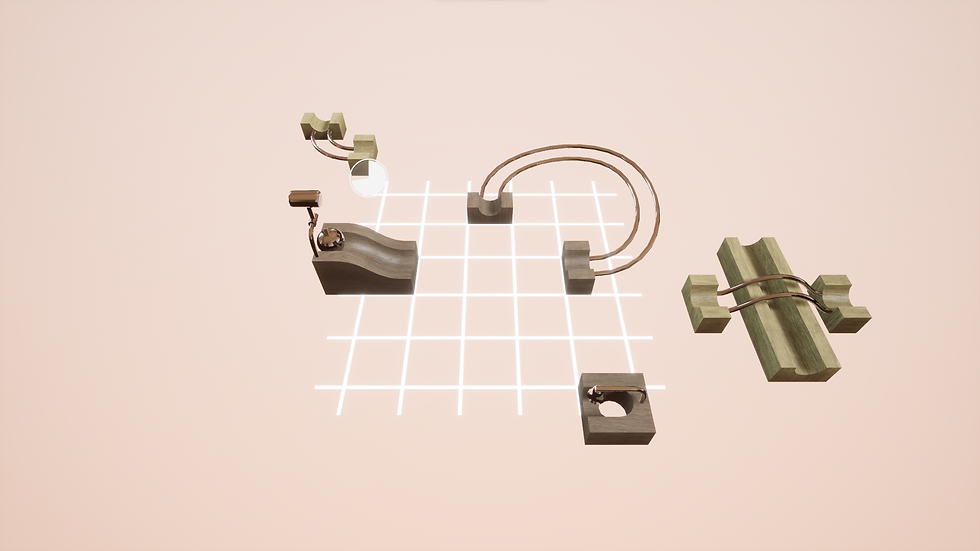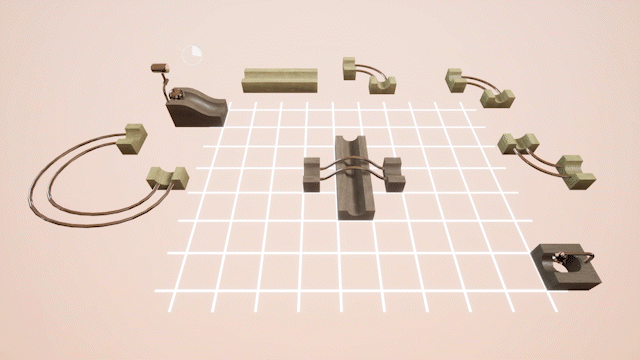
Marbleous was created during the 2-day Climax Game Jam (2022) with peers from the MA Game Design course at Teesside University. With the theme of Chain, we sought to design a satisfying zen puzzle experience, where the player would assemble a chain-like sequence of pieces to complete each level.

Marbleous
2022
UI/UX Design
Game Jam
Onboarding
With Marbleous being a casual game with a simple playstyle, there was not much urgency to have a great deal of onboarding, as the player would understand the overall gameplay loop within a few levels. Future onboarding would have been implemented as new pieces were introduced that required new interactions from the player, if Marbleous was to be released as a full standalone game.
With Marbleous having such a simple control scheme and the game consisting of only a few levels, I felt as though it wasn't necessary to have a control's menu for players to refer back to, instead, the controls are taught to the player in specific levels within the game space; simple game, simple UI. For example, in the first level, the player is taught how to move pieces. Making the words Click and Drag have a bold style compared to the rest of the text gives these words a higher sense of priority against the rest of the text, allowing the player to understand what interaction is needed without necessarily reading the entire text. These instructions persist through each level they are presented in, so if the player were to fail a level, the intructions will still be there on their next attempt.
With Marbleous being a casual game with a simple playstyle, there was not much urgency to have a great deal of onboarding, as the player would understand the overall gameplay loop within a few levels. Future onboarding would have been implemented as new pieces were introduced that required new interactions from the player, if Marbleous was to be released as a full standalone game.
With Marbleous having such a simple control scheme and the game consisting of only a few levels, I felt as though it wasn't necessary to have a control's menu for players to refer back to, instead, the controls are taught to the player in specific levels within the game space; simple game, simple UI. For example, in the first level, the player is taught how to move pieces. Making the words Click and Drag have a bold style compared to the rest of the text gives these words a higher sense of priority against the rest of the text, allowing the player to understand what interaction is needed without necessarily reading the entire text. These instructions persist through each level they are presented in, so if the player were to fail a level, the intructions will still be there on their next attempt.
I wanted to provide feedback to the player regarding the placement of a puzzle piece. Changing the colour of the placed piece as the ball comes in contact with it was the simplest way to provide feedback to the player that the piece is now locked in and can't be moved again.
Alongside this, a visual radial timer that communicates to the player the remaining time until the ball is released was also implemented. When the ball reaches the end goal, a bell chime effect plays, providing feedback to the player that their solution to the puzzle was correct.
To help players manoeuvre the puzzle pieces, a grid based movement system was added, which is visually present in the game space, this allows pieces to be snapped to specific points allowing for precise movement.


Player Progression

As the player progresses through levels, they are met with a variety of puzzles with varying layouts that have multiple solutions. There are also some puzzles that have pieces already set in place for the player, this is both used as an aid for the player and an extra challenge as they have to utilise that set piece. In the early levels, with the game space being so small, these set pieces are placed in areas which make solving the puzzle straightforward. However, as the game space increases in later levels, these set pieces are placed in more isolated areas, making the player work to find the correct solution.
Puzzle pieces become more exotic as the levels increase in difficulty, such as a puzzle piece that curves outside the map. I wanted to show the player that it is okay for the elements of the puzzle piece to be outside the grid play space, as long as the wooden portions of the piece remained within the grid.
Player Control

Puzzle pieces that can be used are placed around the edge of the game space, this works well for levels that don't require too many pieces, but the player progresses through levels a higher number of, and more intricate, puzzle pieces are at the player's disposal. This can lead to the game space feeling cluttered as well as certain pieces being slightly out of camera frame. To compensate for this, an orbital camera was implemented, so the player, can not only see every puzzle piece, but they can also view the puzzle in different perspectives which may help with coming up with a solution to a puzzle they may be stuck on.



